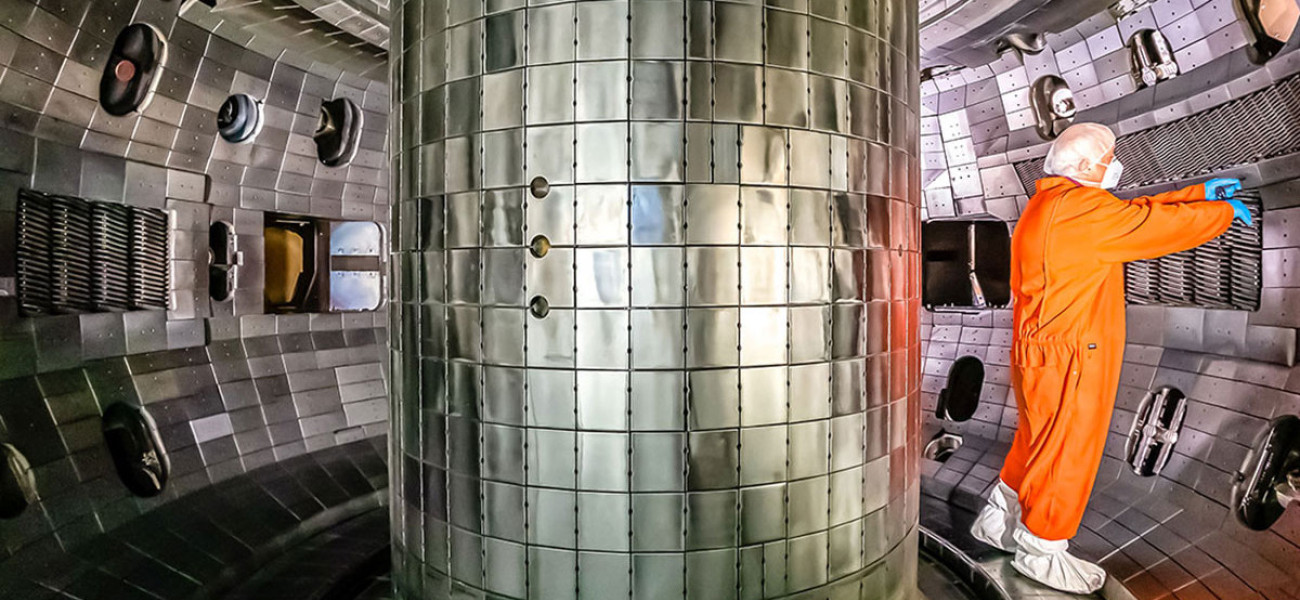
The vessel for a fusion reaction is called a tokamak, like the one at the DIII-D facility in San Diego. - Credit: DIII-D
Science breakthrough
With the help of supercomputers at the National Energy Research Scientific Computing Center (NERSC), researchers at the Princeton Plasma Physics Laboratory (PPPL) have confirmed through simulations a method that stops the production of certain unused waves, improving the efficiency of the fusion reaction. Their work was published in the journal Physics of Plasmas.
Science background
In the process of heating plasma to temperatures required for fusion to occur, a type of wave in the burning plasma known as a slow mode is sometimes produced. These slow modes do not contribute to heating the plasma and are considered wasted energy. However, scientists at PPPL were able to find through a series of simulations that placing a metal grate called a Faraday screen at a 5% angle relative to the antenna producing the heating waves (also known as helicon waves) stops the slow modes from forming. In the simulations, the energy that would have gone into the slow modes went instead into heating the plasma, making a more efficient reaction.
Science breakdown
To run the simulations, the team used NERSC’s current flagship system, Perlmutter, to continue work that started on NERSC’s Cori supercomputer, which has since been retired. The project incorporated full-wave simulations using the Petra-M Finite Element Method (FEM) platform developed by Dr. Syun'ichi Shiraiwa at PPPL. Petra-M efficiently analyzes radio frequency waves – like helicon waves – in both fusion and space plasmas.
Fine-meshed simulations are needed to accurately capture the slow modes. Petra-M’s ability to generate non-uniform meshes allowed the researchers to efficiently conduct simulations in both 2D and 3D. They carried out a numerical survey consisting of over 100 different 2D simulations with varying physics parameters.
Research lead
E.H. Kim
Co-authors
M. Ono, S. Shiraiwa, N. Bertelli, M. Poulos, B. Van Compernolle, A. Bortolon, R. I. Pinsker
Publication
Full-wave simulations on helicon and parasitic excitation of slow waves near the edge plasma, Phys. Plasmas 31, 102102 (2024), DOI: 0.1063/5.0222413
Funding
U.S. DOE Office of Science, Office of Advanced Scientific Computing Research, Office of Fusion Energy Sciences
About NERSC and Berkeley Lab
The National Energy Research Scientific Computing Center (NERSC) is the mission computing facility for the U.S. Department of Energy Office of Science, the nation’s single largest supporter of basic research in the physical sciences.
Located at Lawrence Berkeley National Laboratory (Berkeley Lab), NERSC serves 11,000 scientists at national laboratories and universities researching a wide range of problems in climate, fusion energy, materials sciences, physics, chemistry, computational biology, and other disciplines. An average of 2,000 peer-reviewed science results a year rely on NERSC resources and expertise, which has also supported the work of seven Nobel Prize-winning scientists and teams.
NERSC is a U.S. Department of Energy Office of Science User Facility.
Media contact: Email our communications team ⟶